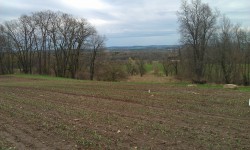Spring Garlic Recommendations
Crystal Stewart-Courtens, Extension Vegetable Specialist
Eastern New York Commercial Horticulture
April 2, 2012

Weed control: Once weeds are allowed to establish in a garlic field, garlic is virtually unable to compete for water, nutrients and light. The key to weed control is to take care of weeds early. There are a few chemical controls available (Table 1). Clean, weed-free mulch is often applied in the fall after the ground freezes and may be left on through the growing season. This will suppress germination of annual weeds. Perennial weeds should be controlled physically or chemically prior to planting in the fall, because they are nearly impossible to control during the growing season. Surface cultivation between rows to control seedlings is effective, but in-row mechanical cultivation is quite disruptive. Flame weeding of seedlings between rows is also effective if no hay mulch is being used. -CLS
Garlic Fertility Table 1 (pdf; 184KB)

Upcoming Events
2025 Potato Advisory Meeting
December 16, 2025
Canandaigua, NY
Come hear the latest on insect pest control and fertility management in potatoes from Cornell University experts. Potato variety trial updates will be shared too. After lunch will be the Empire State Potato Grower's Meeting. 1.5 DEC credits in 10, 1a, and 23.
2026 Finger Lakes Produce Auction Winter Growers Meeting
January 8, 2026
Penn Yan, NY
At this vegetable grower-focused meeting, ag industry experts will discuss food safety, disease management in strawberries, the benefits of using cover crops, plus more. Two grower panel discussions will focus on pest management techniques and irrigation. DEC recertification credits offered in categories 10, 1a, 21, 22, 23, and 24.


































